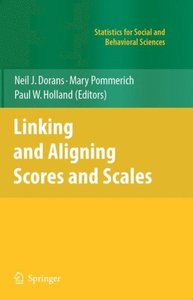Albert Maydeu-Olivares, John J. McArdle (Eds) | Lawrence Erlbaum (2005) | ISBN-10: 0805846085 | PDF | 32 Mb | 600 pages
This book is in celebration of the seminal work of Roderick P. McDonald whose work in psychometrics has inspired the research of many of the leading scholars in this field.
Contemporary Psychometrics features cutting edge chapters organized in four sections: test theory, factor analysis, structural equation modeling, and multivariate analysis. The section on test theory includes topics http://www.blogger.com/post-edit.g?blogID=3699205727318598834&postID=1023422392414479460such as multidimensional item response theory (IRT), the relationship between IRT and factor analysis, estimation and testing of these models, and basic measurement issues that are often neglected. The factor analysis section reviews the history and development of the model, factorial invariance and factor analysis indeterminacy, and Bayesian inference for factor scores and parameter estimates. The section on structural equation modeling (SEM) includes the general algebraic-graphic rules for latent variable SEM, a survey of goodness of fit assessment, SEM resampling methods, a discussion of how to compare correlations between and within independent samples, dynamic factor models based on ARMA time series models, and multi-level factor analysis models for continuous and discrete data. The final section on multivariate analysis includes topics such as dual scaling of ordinal data, model specification and missing data problems in time series models, and a discussion of the themes that run through all multivariate methods.
This tour de force through contemporary psychometrics will appeal to advanced students and researchers in the social and behavioral sciences and education, as well as methodologists from other disciplines,
Download / Descargar
Table of Contents
Contents: Preface. Roderick P. McDonald: A Personal Story.
Part I: Test Theory. T.A. Ackerman, Multidimensional Item Response Theory Modeling. D.M. Bolt, Limited- and Full-Information Estimation of Item Response Theory Models. A. Maydeu-Olivares, Linear Item Response Theory, Non-Linear Item Response Theory and Factor Analysis: A Unified Framework. J.L. Horn, Neglected Thinking About Measurement in Behavioral Science Research.
Part II: Factor Analysis Models. W.R. Krane, K.L. Slaney, A General Introduction to the Common Factor Model. R.E. Millsap, Four Unresolved Problems in Studies of Factorial Invariance. S.A. Mulaik, Looking Back on the Indeterminacy Controversies in Factor Analysis. M. Aitkin, I. Aitkin, Bayesian Inference for Factor Scores.
Part III: Structural Equation Models and Related Methods. J.J. McArdle, The Development of the RAM Rules for Latent Variable Structural Equation Modeling. H.W. Marsh, K-T. Hau, D. Grayson, Goodness of Fit in Structural Equation Modeling. W.M. Hartmann, Resampling Methods in Structural Equation Modeling. J.H. Steiger, Comparing Correlations: Pattern Hypothesis Tests Between and/or Within Independent Samples. M.W. Browne, J.R. Nesselroade, Representing Psychological Processes With Dynamic Factor Models: Some Promising Uses and Extensions of Autoregressive Moving Average Time Series Models. H. Goldstein, W. Browne, Multilevel Factor Analysis Models for Continuous and Discrete Data.
Part IV: Multivariate Analysis. S. Nishisato, On the Scaling of Ordinal Measurement: A Dual-Scaling Perspective. W.F. Velicer, S.M. Colby, Missing Data and the General Transformation Approach to Time Series Analysis. L.L. Harlow, Making Meaning of Multivariate Methods.






